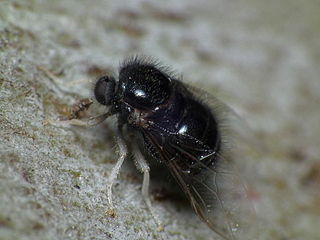
Psychodidae, also called drain flies, sink flies, filter flies, sewer flies, or sewer gnats, is a family of true flies. Some genera have short, hairy bodies and wings, giving them a "furry" moth-like appearance, hence one of their common names, moth flies. Members of the sub-family Phlebotominae, which are hematophagous, may be called sand flies in some countries, although this term is also used for other unrelated flies.

Tanyderidae, sometimes called primitive crane flies, are long, thin, delicate flies with spotted wings, superficially similar in appearance to some Tipulidae, Trichoceridae, and Ptychopteridae. Most species are restricted in distribution. They are found in many parts of the world, including North America, South America, Africa, Australia, New Zealand, and various islands in the Pacific Ocean. Adults are usually found hanging from vegetation near streams. Larvae are found either in sandy stream margins or in wet, rotten wood. Fossil species are known.

The Acroceridae are a small family of odd-looking flies. They have a hump-backed appearance with a strikingly small head, generally with a long proboscis for accessing nectar. They are rare and not widely known. The most frequently applied common names are small-headed flies or hunch-back flies. Many are bee or wasp mimics. Because they are parasitoids of spiders, they also are sometimes known as spider flies.

Anthomyzidae is small, slender, yellow to black flies with narrow and elongated wings, which may have distinct markings. Some species have greatly reduced wings. Fewer than 100 species are known, mostly from Europe. Although they occur in all major regions, they seem to be most varied in the Holarctic region.

Nemestrinidae, or tangle-veined flies is a family of flies in the superfamily Nemestrinoidea, closely related to Acroceridae. The family is small but distributed worldwide, with about 300 species in 34 genera. Larvae are endoparasitoids of either grasshoppers (Trichopsideinae) or scarab beetles (Hirmoneurinae). Some are considered important in the control of grasshopper populations. Adults are often observed on flowers.

Acrocerinae is a subfamily of small-headed flies in the family Acroceridae. Their larvae are endoparasites of araneomorph spiders, with the exception of Carvalhoa appendiculata which can develop as ectoparasitoids on their host spiders. Traditionally, the subfamily included the genera now placed in Cyrtinae and Ogcodinae, but the subfamily in this sense was found to be polyphyletic and was split up in 2019.

Philopotinae is a subfamily of small-headed flies. They have an arched body shape, as well as enlarged postpronotal lobes that form a collar behind the head. Their larvae are endoparasites of araneomorph spiders in the subgroup Entelegynae.

Rivne amber, occasionally called Ukrainian amber, is amber found in the Rivne Oblast and surrounding regions of Ukraine and Belarus. The amber is dated between Late Eocene and Early Miocene, and suggested to be contemporaneous to Baltic amber. Major exploration and mining of the amber did not start until the 1990s.

Ogcodes is a genus of small-headed flies in the family Acroceridae. About 90 species have been described for the genus.
Archocyrtus is an extinct genus of small-headed flies in the family Acroceridae. The genus is known from compression fossils from the Late Jurassic Karabastau Formation of Kazakhstan. The genus is the only member of the subfamily Archocyrtinae.
Cyrtinella is an extinct genus of small-headed flies in the family Acroceridae. The genus is known from Baltic amber from the Eocene of Poland and Kaliningrad Oblast, Russia. It contains only one species, Cyrtinella flavinigra.

Schlingeromyia is an extinct genus of small-headed flies in the family Acroceridae. The genus is known from Upper Cretaceous fossils in Burmese amber from Myanmar. It contains only one species, Schlingeromyia minuta.
Villalites is an extinct genus of small-headed flies in the family Acroceridae. It is known from Baltic amber from the Eocene, though the locality is unknown. It contains only one species, Villalites electrica.

Burmacyrtus is an extinct genus of small-headed flies of uncertain placement. The genus is known from Upper Cretaceous fossils in amber from Myanmar. It contains only one species, Burmacyrtus rusmithi.
Archaeterphis is an extinct genus of small-headed flies in the family Acroceridae. It is known from Baltic amber from the Eocene, though the locality is unknown. It contains only one species, Archaeterphis hennigi.
Eulonchiella is an extinct genus of small-headed flies in the family Acroceridae. It is known from Baltic amber from the Eocene, though the locality is unknown. It contains only one species, Eulonchiella eocenica.
Hoffeinsomyia is an extinct genus of small-headed flies in the family Acroceridae. It is known from Baltic amber from the Eocene of Kaliningrad Oblast, Russia. It contains only one species, Hoffeinsomyia leptogaster.
Prophilopota is an extinct genus of small-headed flies in the family Acroceridae. It is known from Baltic amber from the Eocene.

Cyrtinae is a subfamily of the Acroceridae. Their larvae are endoparasites of araneomorph spiders in the subgroup Entelegynae.
Rhagionemestriidae is an extinct family of brachyceran flies known from the Jurassic and Cretaceous periods. It was first named as a subfamily of the Nemestrinidae by Ussatchov (1968), and was raised to full family status by Nagatomi and Yang (1998). They are considered to be closely related to the family Acroceridae. Similar to Acroceridae, members of the family possess a large hemispherical head, with eyes covering nearly all of the area.











